| |
Observing
tips: Look
west 30 to 60 minutes after sunset when
the Sun has dipped 6o to 16o below the horizon.
If you see luminous blue-white tendrils spreading across the sky,
you've probably spotted a noctilucent
cloud. Although
noctilucent clouds appear most often at arctic latitudes, they have
been sighted in recent years
as far south as Colorado, Utah and Virginia. NLCs are seasonal,
appearing most often in late spring and summer. In the northern
hemisphere, the best time to look would be between mid-May and the
end of August. See also 2003,
2004, 2005,
2006, 2007,
and 2008 |
 |
| |
| |
Photographer,
Location |
Images |
Comments |
|
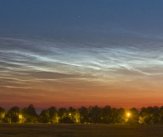
movies:
#1, #2
|
Christoph
Rollwagen,
Potsdam-Bornstedt, Germany
Jun. 16, 2009 |
movies: #1,
#2 |
When I noticed the very
strong display of Noctilucnt Clouds last evening, the skies
were already quite dark, but the clouds were bright and
showed an intense contrast to the deep blue sky. I took
my bike and went out to the field to take several images.
These are my first images of NLCs for the current year.
I hope for more coming up during the next days. Enjoy the
movie show!
;)
|
|
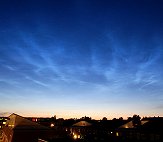
|
Peter
Paul Hattinga Verschure,
Deventer, the Netherlands
Jun. 16, 2009 |
#1,
#2,
#3,
more |
Very
bright and wide-spread noctilucent clouds in the evening
sky of 16 June. Many forms were present. Photographs were
made at 21.12, 21.25, and 21.41 UT, with Nikon D80 with
Sigma 10-20mm lens, 400ASA. |
|
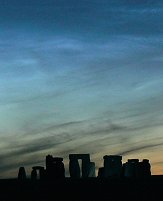
|
Grant
Privett,
Salisbury Plain, Wiltshire, UK.
Jun. 16, 2009 |
#1 |
Taken
around 11:20pm BST at the Stonehenge neolithic circle in
Wiltshire, UK. What had started out as a nice display had
started to decline by this point, but was still quite pretty.
Not as bright as the previous night. Taken with a Panasonic
Lumix DMC-FZ7 - not a DSLR - using a 60s exposure. Taken
from a location 5ft away from the busy A30 trunk road. |
|
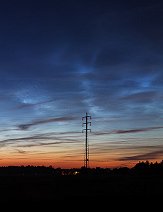
|
Koen
van Gorp,
Sombeke, Belgium
Jun. 16, 2009 |
#1,
more |
The
first display of NLC's in Belgium turned out to be a fairly
bright one. Details: Panorama of 7 images with Canon 40D
and 17-40mm f/4 at 40mm f/5.6, ISO 400 and 4s exposure.
|
|
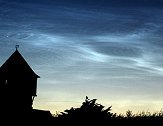
|
Pete
Lawrence,
Selsey, West Sussex, UK
Jun. 16, 2009 |
#1,
#2, #3 |
Wow
- a fantastic NLC display visible from southern England
this evening. One of these shots shows two planes crossing
in front of the distant NLCs. Another shows a normal tropospheric
cloud appearing dark in front of the brighter NLCs, while
the last picture shows off the beauty of the clouds. Now
waiting for the morning show (hopefully!). |
|
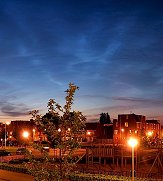
|
Damien
Bouic,
Rotterdam
Jun. 16, 2009 |
#1,
#2, #3,
more |
Wow!
This was the greatest set of NLC I've ever seen from this
time. They were so bright that it was possible to see it
on the LCD display of my digital camera! I think I will
never forget this evenning! Kodak Easyshare ZD710 63 iso,
about 8s exposure. |
more
images: from
Glyn Jones of Newcastle-Under-Lyme, Staffordshire, UK;
|
|
|







